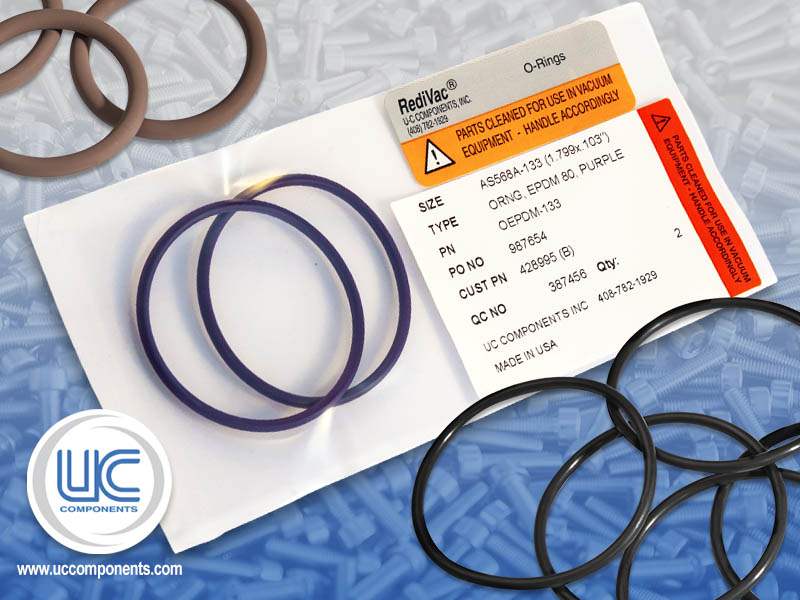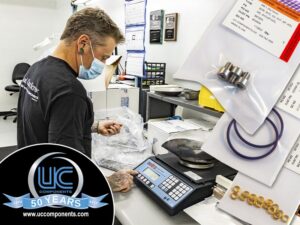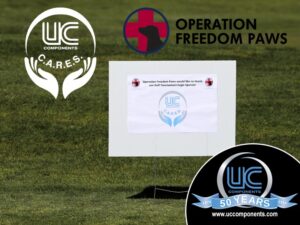There are a variety of O-rings on the market today which vary widely from manufacturer to manufacturer, the source of the materials used, and even from lot to lot. An O-ring is a round solid rubber seal that, when compressed between two surfaces, blocks the passage of liquids or gasses. O-rings were first used at the beginning of the 20th century and are still used today in a variety of critical and non-critical applications. These little seals have changed very little in form or function over the years, yet the materials used in their manufacture have become more complex. Essentially O-rings remain a reliable and straightforward solution to an age-old problem.
How does an O-ring work?
O-rings are an incredibly versatile, economical, and highly reliable solution to a wide variety of engineering issues. From pumps, connectors, cylinders, and valves, to seal joints, and more, O-rings prevent leaks and contamination.
The elastomer-based O-ring sits into an engineered groove where it becomes compressed between two or more parts creating a seal. Under pressure, the O-ring will shift towards the side with the least amount of pressure, forcing itself more tightly against the two components, creating a tighter seal.
It is important to not over-stress an O-ring! To seal properly an O-ring needs to deform slightly into a seal groove and different materials deform in different ways, however too much deformation will prevent the O-ring from properly sealing. This deformation is measured using a scale called a durometer. Typically low pressure applications require lower durometer compounds while higher pressure applications require higher durometer compounds. Utilizing a lower durometer compound in a high pressure application can blow the O-ring out of the seal groove which will cause it to fail.
Typical O-ring applications, uses, & materials
High temperature applications, such as aerospace, require O-rings that can withstand extreme heat while continuing to reliably seal. High-pressure resistance (along with high-temperature resistance) is one of the most common requirements needed in O-rings used in industrial and critical applications. The best O-ring materials for these types of applications include nitrile, hydrogenated nitrile, silicone rubber, polyacrylate, and more. Which material selected depends on the specific operating temperature range needed and the most economical option at that specific performance point.
| Material | Typical operating temperature |
| Nitrile | -50° to 120° C (-58° to 248° F) |
| Hydrogenated nitrile | -45° to 150° C (-49° to 302° F) |
| Polyacrylate | -25° to 175° C (-13° to 347° F) |
| Ethylene-Propylene | -50° to 135° C (-58° to 275° F) |
| Chloroprene | -40° to 120° C (-40° to 248° F) |
| Butyl Elastomers | -55° to 205° C (-67° to 401° F) |
| Fluorosilicone | -60° to 205° C (-76° to 401° F) |
| Fluorocarbon | -25° to 205° C (-13° to 401° F) |
| Silicone | Up to 260° C (500° F) |
| Ployurethane | Up to 148° C (300° F) |
Aerospace applications (such as fuel cap gaskets, valve cover seals, or fuel system O-rings, to name a few) also require O-rings that not only withstand extreme temperatures but that are also highly chemical resistant and able to operate in extreme pressures. Common elastomers that offer these characteristics include nitriles, fluorosilicones, ethylene-propylene, and more.
Food-grade O-rings must be manufactured to even more stringent standards of cleanliness and composition than O-rings that will not come into contact with food. Common food-safe O-ring materials include EPDM, fluorocarbon, nitrile, neoprene, and silicone.
Typical O-ring materials include:
| Buna-N | Buna-N are nitrile elastomers that are prized for their excellent abrasion and tear resistance. |
| Fluorocarbon | This elastomer is highly resistant to UV radiation, oxidation, ozone, and petroleum-based lubricants. It offers good temperature resistance (up to 210C) but is prone to failure below -15C. |
| Nitrile (also known as NBR) | One of the most widely used O-ring elastomers. They offer reasonable resistance to water, gasoline, petroleum oils, crude oil, propane, and more. Nitrile compounds are classified into categories based on the percentage of nitrile content – 1*% or lower is considered low nitrile, medium nitrile is up to 32%, 50% or more is considered high nitrile. Nitrile is ideal in low temperature applications which require high oil resistance. |
| Silicone | Silicone is another elastomer that is very widely used. Silicone offers very good resistance to ozone, water, acids, weathering, and heat. |
Finding the Right Seal
Choosing the right O-ring is critical to ensure a proper seal. However, finding exactly the right seal for your application can be challenging. Prior to selecting a seal for your specific application, it is best that you consult an expert.
How can O-rings from UC Components, Inc. help you?
UC Components’ RediVac® O-rings are specially processed for use in a wide variety of critical applications. All of our O-rings are cleaned and packaged in our certified Class 100/ISO Class 5 Cleanroom, making them suitable for immediate use in most HV, UHV, or EUV applications. Vacuum baked O-rings are available for reduced outgassing under vacuum.
View our parts catalog online to find the components you need, request a quote, or contact us for more assistance or additional information. If you do not see the items that you need listed in our standard products, please give us a call! We may not stock it but we are happy to acquire and manufacture just about any fastener or O-ring that you need.



